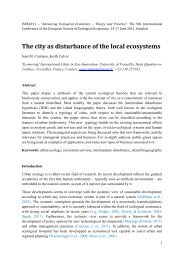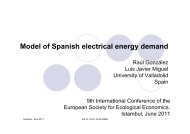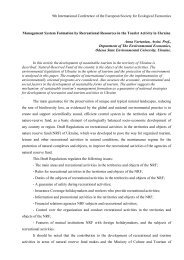Full Paper - ESEE 2011 - Advancing Ecological Economics
Full Paper - ESEE 2011 - Advancing Ecological Economics
Full Paper - ESEE 2011 - Advancing Ecological Economics
Create successful ePaper yourself
Turn your PDF publications into a flip-book with our unique Google optimized e-Paper software.
Figure 1 UK GHG Emissions, 1992 to 2004 using different accounting methods, WRAP 2009<br />
CBA provides an additional mechanism for countries to understand the impact that their<br />
consumption of goods and services has on carbon emissions regardless of territorial boundaries.<br />
Whilst there are both advantages and disadvantages to this accounting method in terms of data and<br />
methodology (see Technical Limitations section), it can provide a valuable insight insight, particularly from a<br />
policy perspective. It t can be useful to explore the potential for and importance of policy intervention<br />
to encourage mitigation in a trading partner (Glen P. Peters 2008) and the avoidance of carbon<br />
leakage to countries with no binding emissions reduction targets targets. . This can provide information to<br />
help address the challenge lenge posed by the geographical separation between consumption and the<br />
GHGs emitted in the production of consumable items (Sangwon Suh 2010). It has also been<br />
recognised that the adoption of such a consumption<br />
consumption-based perspective — in addition to the<br />
traditional approach of territorial emissions accounting — opens up the possibility of extending the<br />
range of policy and research applica applications considerably to cover sectoral, , country and product<br />
analysis (Thomas Wiedmann 2009) 2009).<br />
In the international policy framework tthe<br />
he concern with carbon leakage would become unnecessary if<br />
legally binding territorial emissions targets were agreed and achieved across the world and<br />
emissions were successfully reduced to minimal and similar per capita levels across countries countries.<br />
However, until ntil this is a reality, CBA can be useful to help countries understand the true extent of<br />
their impact and potential areas of influence beyond their national boundaries.<br />
Global emissions targets<br />
This paper is set in the context of global climate change and<br />
to a level where there is a minimised risk of dangerous climate change.<br />
in the UK and EU focuses on the avoidance of dangerous climate change, which is interpreted as<br />
contributing to the effort to stabilise global mean surface temperature increases to no more than<br />
2 o This paper is set in the context of global climate change and the necessity to reduce GHG emissions<br />
to a level where there is a minimised risk of dangerous climate change. Current climate policy both<br />
in the UK and EU focuses on the avoidance of dangerous climate change, which is interpreted as<br />
ffort to stabilise global mean surface temperature increases to no more than<br />
C (Schneider et al 2006; the Committee on Climate Change 2008). In order to stabilise at such a<br />
level, the cumulative release of global emissions must be limited to a level comm commensurate with this<br />
degree of change (Zickfeld et al 2009). The alternative if those targets are not met is a greater risk of<br />
3







